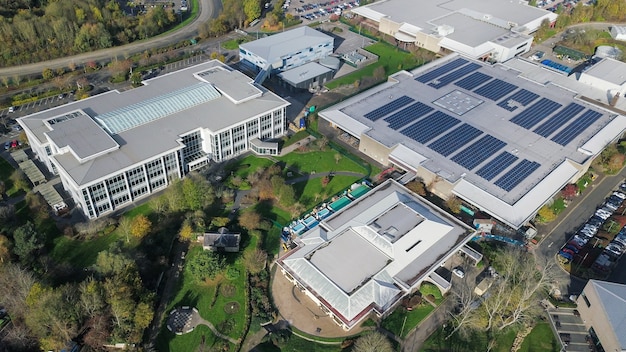How to Develop a Sustainable Business Model for Long-Term Success

Developing a sustainable business model ensures long-term success by integrating environmentally and socially responsible practices into core operations, enhancing brand reputation, and securing lasting profitability.
In today’s rapidly changing business landscape, creating a sustainable business model for long-term success is no longer just an option; it’s a necessity. Companies are increasingly recognizing the importance of integrating environmental, social, and governance (ESG) factors into their core strategies to thrive.
Understanding the Essence of a Sustainable Business Model
A sustainable business model goes beyond traditional profit-driven approaches. It incorporates practices that minimize environmental impact, promote social responsibility, and ensure long-term economic viability. This holistic approach not only benefits the planet and society but also strengthens a company’s resilience and competitive advantage.
Defining Sustainability in Business
Sustainability in business means operating in a way that meets the needs of the present without compromising the ability of future generations to meet their own needs. It involves considering the environmental, social, and economic impacts of business operations.
Key Components of a Sustainable Model
A sustainable business model focuses on minimizing waste, using resources efficiently, and creating value for all stakeholders. It integrates eco-friendly practices and ethical considerations into every aspect of the business.
- Eco-Efficiency: Reducing waste and maximizing resource utilization.
- Stakeholder Engagement: Involving employees, customers, suppliers, and communities in decision-making.
- Ethical Sourcing: Ensuring fair labor practices and responsible supply chains.
- Long-Term Vision: Prioritizing sustainable growth over short-term gains.
By embracing these components, businesses can build a resilient and prosperous future, aligning their goals with the broader needs of society and the environment. This integration not only boosts their bottom line but also enhances their reputation and fosters long-term trust with consumers and stakeholders.
Incorporating Environmental Considerations
Integrating environmental considerations into your business model is crucial for long-term sustainability. This involves adopting practices that minimize your company’s carbon footprint, conserve resources, and reduce pollution. By prioritizing environmental stewardship, businesses can not only protect the planet but also improve their operational efficiency and attract environmentally conscious consumers.

Reducing Carbon Footprint
One key step in environmental sustainability is reducing your carbon footprint. This can be achieved through energy efficiency measures, using renewable energy sources, and implementing sustainable transportation practices.
Waste Reduction and Recycling Programs
Implementing effective waste reduction and recycling programs can significantly minimize environmental impact. This involves reducing waste generation, reusing materials, and recycling as much as possible.
- Implementing a Comprehensive Recycling Program: Ensure bins are readily available and clearly labeled.
- Reducing Packaging Waste: Use minimal and recyclable packaging materials.
- Donating or Repurposing Excess Materials: Find ways to give materials a second life.
- Composting Organic Waste: Reduce landfill waste and create valuable soil amendments.
By focusing on these initiatives, businesses can make significant strides in reducing their environmental impact and promoting a culture of sustainability within their operations. These actions not only contribute to a healthier planet but also enhance the company’s brand image and appeal to environmentally conscious customers.
Embracing Social Responsibility
Embracing social responsibility means integrating ethical practices and community engagement into your business operations. This involves ensuring fair labor practices, supporting local communities, and promoting diversity and inclusion. By prioritizing social well-being, businesses can build stronger relationships with stakeholders and enhance their overall reputation.
Fair Labor Practices
Ensuring fair labor practices is fundamental to social responsibility. This includes providing fair wages, safe working conditions, and opportunities for professional development.
Community Engagement and Support
Supporting local communities through charitable donations, volunteer programs, and community development initiatives can create a positive social impact. This fosters goodwill and strengthens relationships with the community.

Promoting Diversity and Inclusion
Creating a diverse and inclusive workplace can foster innovation, creativity, and employee satisfaction. This involves ensuring equal opportunities for all employees, regardless of their background or identity.
- Implementing Diversity and Inclusion Training Programs: Educate employees on unconscious bias and inclusive behaviors.
- Creating Employee Resource Groups: Support and empower employees from diverse backgrounds.
- Ensuring Equal Opportunities in Hiring and Promotion: Remove barriers to advancement for underrepresented groups.
By embracing social responsibility, businesses can create a positive impact on society and build a strong foundation for long-term success. Socially responsible practices not only attract and retain top talent but also resonate with consumers who increasingly prioritize ethical and sustainable brands. This commitment enhances brand reputation and fosters a culture of integrity and social consciousness within the organization.
Achieving Economic Viability
Economic viability is essential for a sustainable business model. This involves ensuring profitability, efficient resource management, and long-term financial stability. By prioritizing economic sustainability, businesses can ensure their long-term survival and create value for shareholders and stakeholders alike.
Ensuring Profitability
Maintaining profitability is crucial for any business to thrive. This involves optimizing operations, reducing costs, and increasing revenue through sustainable products and services.
Efficient Resource Management
Managing resources efficiently can reduce costs and minimize environmental impact. This includes conserving energy, water, and raw materials, as well as reducing waste.
Long-Term Financial Stability
Building long-term financial stability involves diversifying revenue streams, managing debt responsibly, and investing in innovation and sustainable practices.
- Diversifying Revenue Streams: Explore new markets and sustainable product offerings.
- Managing Debt Responsibly: Avoid excessive borrowing and maintain a healthy balance sheet.
- Investing in Innovation: Develop new technologies and processes that improve efficiency and sustainability.
- Adopting Circular Economy Principles: Design products for durability, reuse, and recyclability.
By focusing on these key areas, businesses can ensure their economic viability and create sustainable value for the long term. This approach not only secures their financial future but also positions them as leaders in sustainable business practices, attracting investors and customers who value long-term growth and responsible management.
Measuring and Reporting Sustainability Performance
Measuring and reporting sustainability performance is essential for tracking progress, identifying areas for improvement, and demonstrating accountability to stakeholders. This involves setting clear sustainability goals, collecting relevant data, and reporting performance transparently. By measuring and reporting sustainability impacts, businesses can improve their environmental and social performance and enhance their reputation.
Setting Sustainability Goals
Establishing clear and measurable sustainability goals provides a roadmap for improvement. These goals should be aligned with your business strategy and address your most significant environmental and social impacts.
Collecting Relevant Data
Collecting accurate and relevant data is crucial for tracking progress towards your sustainability goals. This involves monitoring key performance indicators (KPIs) related to energy consumption, waste generation, carbon emissions, and social impact.
Transparent Reporting
Reporting your sustainability performance transparently can enhance your credibility and build trust with stakeholders. This involves disclosing your sustainability goals, data, and progress in a clear and accessible manner.
By measuring, reporting, and communicating your sustainability performance, businesses can demonstrate their commitment to responsible practices and build stronger relationships with stakeholders. This transparency not only fosters trust but also drives continuous improvement and positions the company as a leader in sustainable business.
Case Studies of Successful Sustainable Business Models
Examining case studies of successful sustainable business models can provide valuable insights and inspiration for businesses looking to integrate sustainability into their operations. These examples demonstrate how companies have successfully balanced economic, environmental, and social considerations to achieve long-term success. From Patagonia’s commitment to environmental conservation to Unilever’s sustainable living plan, these companies serve as models for sustainable business practices.
Patagonia: Environmental Conservation
Patagonia is renowned for its commitment to environmental conservation and ethical manufacturing practices. The company donates a percentage of its sales to environmental organizations and advocates for responsible business practices.
Unilever: Sustainable Living Plan
Unilever’s Sustainable Living Plan aims to decouple the company’s growth from its environmental impact while increasing its positive social impact. The plan focuses on improving health and well-being, reducing environmental impact, and enhancing livelihoods.
Interface: Mission Zero
Interface, a global flooring manufacturer, has committed to “Mission Zero,” an ambitious goal to eliminate any negative impact the company has on the environment by 2020. It showcases how businesses can successfully integrate environmental considerations into their operations.
These case studies highlight the diverse approaches businesses can take to integrate sustainability into their core strategies. While each company operates in a unique context, they share a common commitment to balancing economic, environmental, and social considerations. These examples demonstrate that sustainable business models are not only possible but can also drive long-term success, innovation, and positive change.
| Key Aspect | Brief Description |
|---|---|
| 🌱 Environmental Impact | Reducing carbon footprint and waste to protect the environment. |
| 🤝 Social Responsibility | Ensuring fair labor and supporting communities. |
| 💰Economic Viability | Maintaining profitability through efficient resource management. |
| 📊 Performance Measurement | Tracking sustainability goals and reporting transparently. |
FAQ Section
A sustainable business model integrates environmental, social, and economic considerations into its core operations to ensure long-term viability and positive impact.
Sustainability enhances brand reputation, attracts environmentally conscious consumers, and ensures long-term resource availability, fostering resilience and competitiveness in the market.
Businesses can reduce their carbon footprint by implementing energy-efficient practices, using renewable energy sources, and optimizing transportation and supply chain operations.
Fair labor practices include providing fair wages, safe working conditions, and opportunities for professional development, ensuring the well-being and rights of employees.
Companies can ensure economic viability by managing resources efficiently, diversifying revenue streams, and investing in innovation to optimize operations and achieve long-term financial stability.
Conclusion
Developing a sustainable business model for long-term success requires a holistic approach that integrates environmental, social, and economic considerations into every aspect of your business. By embracing sustainability, companies can build a more resilient, responsible, and prosperous future for themselves and the planet.